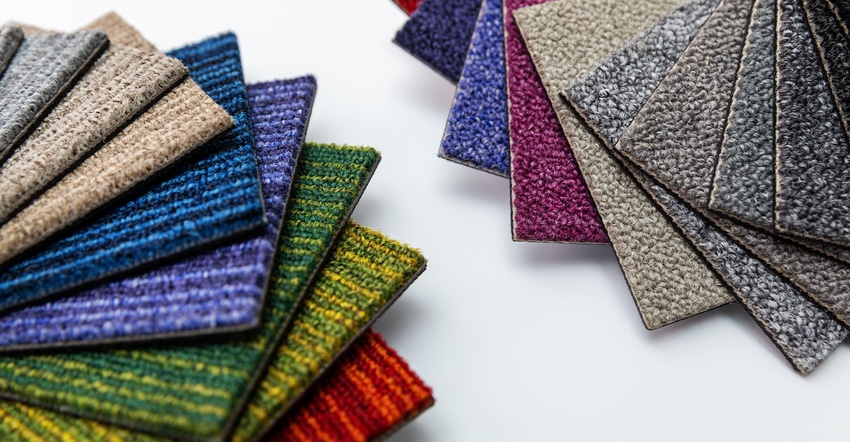Moving the Needle on Flooring Sustainability: Part One
The carpet and flooring industry has been in the limelight for its sustainability practices, and sometimes lack of such practices, for years. Part 1 of this two-part series tells some of the story of how global manufacturers Interface and Aquafil have blazed green trails and are calling on the industry as a whole to take on more responsibility for its products from the cradle to the grave.

The carpet and flooring industry has been in the limelight for its sustainability practices, and sometimes lack of such practices, for years. Part 1 of this two-part series tells some of the story of how global manufacturers Interface and Aquafil have blazed green trails and are calling on the industry as a whole to take on more responsibility for its products from cradle to grave.
In Part 2 Heidi Sanborn, executive director of the National Stewardship Action Council, discusses California’s carpet stewardship bill, the first of its kind in the world. She tells of its shortcomings and of a fix it bill in the works to address them. Sanborn sounds the horn on a flooring category rapidly gaining market share with potential environmental ramifications.
In the mid ‘90s flooring manufacturer Interface began fielding a new question from its customers: “What’s your company doing for the environment?” For the carpet maker’s CEO, Ray Anderson, it spurred what he called a “spear in the chest” moment, and then a question of his own: What would it take to turn the enterprise into a truly green operation?
So began the journey to find out. Along the way the now 50-year-old company would achieve some industry firsts—from setting aggressive renewable energy goals to developing innovative carbon sequestration technologies.
Interface reported its environmental footprint for the first time in 1997. Sustainability reporting was a radical concept back then. Who went public with the bad news?
And what came to light definitely was not a fairy tale story. Flooring production consumes huge volumes of fossil fuel and generates mega tons of waste. The impact was even greater back in the day that consumers were just beginning to get curious. With that reality there was room for improvement.
Since 1996 Interface has reduced its waste to landfill by 67 percent and cut greenhouses gas emissions at its manufacturing sites by 97 percent. It runs on 91 percent renewable electricity – 100 percent if you only count power at its production sites.
Today, 66 percent of its carpet tiles are from recycled or biobased sources, with a majority of it being from recycled content. The company’s evolving portfolio now includes a line of tile backings that are carbon negative (from cradle to gate), trapping more greenhouse gases than those associated with the carbon-intensive process of making the face fiber.
Transitioning to these ecofriendly alternatives has been a time- and sometimes capital-intensive process. It’s come with lessons in design and chemistry.
Interface engineers had to figure out how to develop a backing machine that could work with its new biobased and recycled materials–at a cost of $50 million. Scientists had to create and finetune the new product formulations for both sustainability and performance.
“Say you want to mix biobased and recycled material. How do you get them to work together? asks Mikhail Davis, director of technical sustainability, Interface.
“This is something we’ve been evaluating. And we’ve been learning along the way,” he says, recalling an early attempt to make carpet fiber from corn. What looked like a potentially sustainable solution did not pass muster in the performance department.
Though work with a sugarcane backing has proved a success story, providing an alternative to fossil gas while pulling carbon out of the atmosphere.
Since 2016 Interface has collected 70 million pounds of postconsumer carpet globally, which was given a second life through reprocessing internally or through one of its partners.
Aquafil is another pioneer in the carpet manufacturing space, having developed a 100 percent regenerated (recycled) nylon from fishing nets, old carpet, fabric scraps, and other waste.
Branded as ECONYL it can reduce global warming potential up to 90 percent compared to standard nylon, according to Eric Nelson, Aquafil carpet collection executive vice president. For every 10,000 tons of ECONYL nylon that replaces virgin nylon, 70,000 barrels of crude oil are saved and 65,100 metric tons of CO2 are avoided.
“The future of the carpet industry is designing carpets that are made to be recycled and regenerated. Aquafil has been working toward this by investing in the research and development of circular carpets. The goal is to work closely with carpet manufacturers to produce carpets that can be fully disassembled with materials and fibers that are compatible with the ECONYL regeneration system,” Nelson says.
There is more work to be done to move the needle.
“The biggest challenge for us is getting off of oil, so a lot of Interface’s R&D is focused on identifying high-performance, cost-effective materials from other sources. We succeeded in some categories like nylon, but the work is ongoing,” Davis says.
Another challenge that we will likely begin hearing about is around plastic-based hard surface flooring. It’s gaining strong market share, but further behind than other floorings in achieving sustainability, setting the industry back in its work to grow a culture that prioritizes environmentally sound practices.
On the policy front, California leads the pact in the push to green the industry. It’s the only state in the country that’s passed a carpet stewardship law, though New York will follow. But California’s legislation, which imposes a fee on carpets at the time of sale, intended to be used to manage the material at the end of life, has run into funding issues.
Two fix it bills have since come online. And conversations are beginning around a third bill, authored by California Assemblymember Cecilia Aguiar-Curry. She has concerns about how the existing program is managed.
“I want to make sure that Californians’ consumer fees are being used effectively to recycle carpets and create jobs in our state. We need to ensure that there is transparency around how funds are spent and that goals are being met consistently,” Aguiar-Curry says.
The new California bill is on the inactive file on the Senate Floor and will be amended based on forthcoming feedback when the legislature reconvenes.
Aquafil and Interface are among just a few in the industry who lobbied for California’s stewardship law.
“A lot of the industry was against it. We are in support of policy calling for greater manufacturer responsibility [in the way of more sustainable practices] because we see the future being to harvest usable waste rather than to rely on crude oil,” Davis says.
About the Author(s)
You May Also Like




